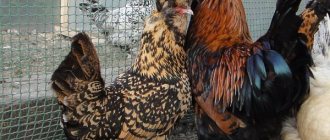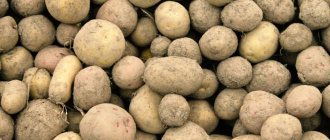What is a rooster for?
When breeding laying hens, it is the females that are important. They are responsible for the production of eggs and are their direct source. But, in this case, a logical question arises: do laying hens need a rooster? You can find many answers to this on the Internet. But only one will be correct.
The fact is that the importance of the male depends on what the eggs are planned to be used for:
- for consumption only;
- for consumption and breeding new offspring.
Do you need a rooster?
In the first case, you can firmly answer that the farm can easily manage without a rooster.
Laying hens will be able to produce eggs without his participation, since he does not take any part in the process of formation of the yolk, white and shell.
But, if we talk about using eggs to hatch chickens, then there is no way without a rooster. It is his participation in the life of the female individual that influences the formation of the embryo, from which the chick subsequently appears. The absence of a rooster in the flock completely reduces to zero the possibility of breeding offspring at home.
Therefore, deciding whether a rooster is needed for chickens is an individual decision. They proceed directly from whether the farm is run for one’s own use or for its constant replenishment.
Differences between a fertilized egg and an unfertilized one
Fertilization is a necessary process for the reproduction of most representatives of the animal world. For laying hens the following algorithm applies:
- an egg is formed in the female body - a yolk is formed;
- the fruit grows until the protective film breaks;
- then the yolk descends through the oviduct to the protein mass;
- egg formation occurs;
- If the rooster's seed appears at the last stage, fertilization occurs.
In a bird's body, sperm can remain alive for up to three weeks. The eggs that chickens lay during this period will be fertilized. If offspring are required, it is better to check each one with a special device - an ovoscope. The device is purchased or made independently. The device is a tube, on one side of which there is a source of bright light, on the other - a device where the egg is placed.
The rate of fetal development and the frequency of egg formation depend on the conditions in the chicken house. In a warm room with sufficient nutrition, hens can lay eggs all year round.
Unfertilized eggs appear without the participation of a rooster. There is no consensus regarding the benefits or harm of such products. Differences are noted on the following points:
- in the absence of a male, eggs contain less harmful substances, cholesterol, and are considered more suitable for dietary nutrition;
- the shelf life of the masonry is shorter;
- the absence of a germ in the yolk is a valuable quality for vegetarians.
It is impossible to distinguish eggs by taste. Research by biologists boils down to the fact that there is no difference in the amount of microelements and vitamins (relates to the stage of development at which the product is consumed). The presence or absence of a rooster still affects the egg production of chickens.
Despite the results of the latest tests, farmers are divided into two camps: some are sure that it is impossible to do without a male, while others are convinced that it is the opposite. It is worth noting that each of the opinions is subjective.
Features of egg formation
In order to understand the influence of the male individual, it is worth analyzing the anatomy of the formation of the egg itself. In a laying hen, the formation of protein, yolk and shell occurs without the participation of a rooster. A new follicle emerges immediately after the egg is released, forming a new embryo.
The rooster has absolutely no influence on this process. It happens constantly without him or with his participation.
What is a rooster for then?
The fact is that the male is directly related to the quality of the egg itself. After fertilization of the chicken, the egg has the opportunity to turn into an embryo with further development into a chicken. That is, thanks to the rooster, new offspring are hatched and the eggs can be used not only for food, but also for a new brood.
The influence of males on laying speed is zero. Whether he fertilized the chicken or not, egg production does not increase in any way. In some cases, everything goes exactly the opposite way. On average, each laying hen produces one egg per day, and in poor external conditions - one egg every two days.
Can hens lay eggs without a rooster? Stages and mechanism of egg formation
Eggs develop constantly in the body of mature chickens. This can be seen when cutting up the carcass of a slaughtered bird: several dozen tiny “yolks” attached to the left ovary:
- The egg grows to form the yolk.
- Having reached 40 mm in diameter, the yolk from the ovary passes into the oviduct.
- The process continues by forming a shell of protein layer by layer.
- After 3 hours, protein formation comes to an end.
- The egg moves to the isthmus of the oviduct, where it is “dressed” in the thinnest film. The preshell film is formed in about 1 hour.
- The next stage is the shell, which takes most of the time, and the supershell layer: this takes the hen about 18 hours.
- An almost finished egg is pushed out of the chicken’s body, and after 40 - 50 minutes the next yolk comes out of the ovary.
The absence of a male cannot stop this process; the eggs will in any case grow and go through all the stages until an egg is formed in the form familiar to people.
Normally, laying hens are able to lay eggs daily if they receive enough vitamins and mineral supplements in their food. In this case, almost all nutrients are spent on the formation of the egg. A good laying hen weighs a little more than 1 - 1.5 kg. Egg production drops only if the conditions of keeping and feeding the bird are not met.
The influence of a rooster on the taste of eggs
You can find opinions that:
- eggs from chickens in which there is a male in the flock are more tasty;
- Fertilized eggs have beneficial properties.
Neither the first nor the second statement is true. The influence of the male is purely physiological. That is, it is limited solely by the ability to breed new chicks. Otherwise there is no difference.
In terms of size, volume and composition, the eggs in both options will be absolutely identical. Fertilization of a chicken by a rooster does not in any way affect the taste and does not make the product more beneficial for the body when consumed. Therefore, you should not believe everything that they write.
Hatching instinct in chickens
As we understand, a chicken, even if it is in your flock without a rooster, will still lay eggs, even if they are empty. However, another question is, will she hatch them? Let's figure out what can affect this.
This instinct was given to the chicken by nature itself, but man brought it to the format he needed.
Chickens and other birds do not have this instinct all the time; it arises only during those periods of their life when birds:
- mate;
- lay eggs.
In fact, the brooding instinct is an analogue of the maternal instinct in other living beings. However, what is interesting is that it is not always the mother who incubates the eggs in a pair of birds. Thus, males are responsible for nurturing embryos in eggs in birds of the following species:
- Jacana birds;
- Nandu ostriches;
- emperor penguin;
- Kiwi, etc.
Unfortunately, some bird species lost their maternal instinct at the behest of nature, while others through human fault during selection. In the wild, the most familiar to us is the negligent cuckoo, after which human mothers who abandoned their children are called by the same name.
Unfortunately, not all hens can boast of a brooding instinct; some are forced to sit on their eggs.
But farm birds often lose their brooding instinct as a result of long-term selection work. So, among chickens there are many breeds that refuse to sit on eggs, for example:
- Leghorn.
- Russian white.
- Silver, etc.
Most often, the brooding instinct awakens in poultry in the spring, when they begin to intensively lay eggs. Sometimes a bird, even without a breed tendency to refuse to hatch, does not even look in the direction of the laid clutch, therefore, sometimes it is forcibly placed on the eggs for several days, secured with something on top.
In many breeds that are the fruit of selection, the incubation instinct can also be improved, because their egg production is continuous, therefore, for the appearance of chicks from previously laid eggs, its constant presence is necessary.
Hormones, as well as environmental influences, can regulate the presence or absence of a hen’s desire to sit on eggs.
The brooding instinct can also be influenced by:
- various hormonal factors;
- influence of the external environment.
By the way, the presence of a rooster can also help stimulate it in the hen, since this way the laying hen will know: since there is a male, there will be offspring, and it is necessary to provide him with the opportunity to be born.
Disadvantages of keeping chickens with a rooster
The question is relevant because many owners know how difficult it can sometimes be to deal with males on the farm. Having a rooster in a flock has a number of disadvantages:
- Aggressive behavior. By nature, the male is called upon to protect the family. Therefore, all the chickens in the flock are constantly under his “supervision.” Often this behavior is expressed in an attack on the owners, strangers, preventing the females from being fed or the eggs taken.
- Appearance of a chicken. To fertilize the female, the male “tramples” her. This process in itself is not very attractive, and its consequences are even more so. As a result, chickens walk around plucked, with scratches that can become infected, causing their later death.
- The desire to breed. The instinct of a fertilized chicken is triggered - it is necessary to hatch the chick. Accordingly, it becomes more difficult to collect eggs, since the laying hen can hide them in a makeshift nest from the owners. In addition, for those who do not want to raise chickens, this result is generally undesirable. In most laying hens, laying hens are bred in the spring and autumn to produce eggs and meat. The appearance of chickens comes as a complete surprise.
Roosters often “trample” their ladies and crow in the morning
Just as some people like the crow of a rooster at dawn, some people find it unpleasant. The presence of a male in the flock necessarily entails his singing in the morning. So, when starting him in a flock, you should be prepared for an early rise.
Disadvantages of keeping a male
If the chicken coop is inhabited only by chickens that lay eggs for consumption, and the owner of the chicken coop is able to restore order on his own, then what is the role of the rooster? Indeed, some breeders believe that roosters cause more trouble, both for the owner and for the hens. Let's look at the reasons why having a rooster in the chicken coop is a minus:
- Aggression. The important task of the rooster is to protect his chicken coop from outside interference, and from anyone, so even if the owner approaches the hens to feed them, an embittered rooster can attack. An angry, attacking rooster is very difficult to resist.
- Chickens show a lower level of egg production . There is some debate regarding this point, as some breeders say that, on the contrary, roosters only help and do not interfere with the hens laying eggs, while others claim that without a rooster, the hens behave much calmer and lay eggs more often.
- Appearance of chickens . Roosters regularly trample hens, which does not add to their attractiveness, since the male scratches and plucks their feathers, leaving wounds that can become infected;
- The desire to hatch chickens. If fertilization has occurred, then the females’ maternal instinct begins to awaken, while they are indifferent to unfertilized eggs. But the downside here is that, trying to hatch eggs, they occupy nests and thereby prevent other chickens from laying eggs.
- The rooster was selected and sent to the coop incorrectly. Chickens may treat him with disdain, which will cause aggression.
Pros of keeping chickens with a rooster
But, despite the rather large shortcomings, experts also highlight a number of positive aspects:
- Fertilization. The first point will be to answer the question of whether a rooster affects the egg production of chickens. Its sole role in fertilization makes it possible to place eggs in an incubator and wait for the chicks to hatch. Without a rooster in the flock, you shouldn’t even try to hatch an egg, since absolutely nothing will come of it.
- Organized pack. Owners who have a rooster for laying hens note that females become more obedient. They do not wander around the area and come running to the first call of their male. The calmness of females depends on the rooster.
- Protection. The rooster is the master of the flock. He can help his family when attacked by other animals, protecting the livestock from the enemy. Also, all the best that the male finds is given to the females.
That is, there is still some delicacy from him. Therefore, it is not worth saying that males are absolutely not needed for chickens. Although the rooster spoils the appearance and creates an aggressive attitude, his care, protection and organization of the flock also play a role.
Chickens' love ritual
Since chickens live in a community, there must certainly be a strict structure in it, at the top of which the most authoritative rooster dominates. But it happens that even the strongest and strongest rooster cannot fight back the smaller one - then leadership is transferred to the latter.
In a chicken family, the most authoritative rooster dominates.
The leader of the community is endowed with significant advantages over other gentlemen. He has the right to mate with any hen and conduct a love ritual at any time convenient for him. The hen does not enjoy the mating process, since the male sits on her back and grabs the back of her head with his beak. You can often observe how the female tries to escape from the excited male, and sometimes she succeeds.
Showing his dominance, the leader constantly looks after the chickens and behaves like a true gentleman. Flirting, he walks around the chicken and scratches the drooping wing with his foot. And having acquired a tasty morsel, without hesitation, share your prey with the female you like. It seems that his tenderness and attention have no boundaries.
The leader watches the chickens and looks after them.
However, with the onset of molting, the situation changes dramatically. The rooster stops showing concern, begins to trample the hens and aggressively drives them away from the feeders and drinkers. With the end of the molting period, peace and idyll return to the chicken family.
How many roosters do you need?
An equally important issue is the number of males per flock. If the owner decides to have a rooster. Then you need to first calculate the number of males.
What is it for? Anyone who has seen a flock with two or more males knows that they rarely make peace with each other. Roosters will constantly fight among themselves for primacy in their flock, for females, etc. In addition, this disrupts organization and increases the overall aggressiveness of the birds.
2 roosters for 13 laying hens is a LOT
Therefore, you need to correctly calculate exactly how many males are needed. Everything here directly depends on the number of females. As a general rule, 10 to 13 laying hens need one rooster. Accordingly, the number of males is derived from the presence of females.
What to do if there are more than 20 chickens in the flock? In this case, it is recommended to divide them into two families, each of which will have its own male. In addition, it is better to create different chicken coops and walking areas for them. This minimizes the likelihood of males fighting.
Accordingly, we can say that the decision on the need for a rooster on the farm should be made in accordance with the goals of raising laying hens.
If you don’t plan to breed them, then you shouldn’t get a male. This is especially true when chickens live in cages. The rooster will only take up extra space and will not affect the number of eggs.
Insemination process
So, we already know how birds copulate. How does fertilization of a chicken egg occur? Or rather, eggs. After all, the egg is formed after fertilization of the egg deposits. Although the chronology of the processes is exactly this: fertilization of an egg - the formation of an egg, the latter will be formed without fertilization.
At first, the egg exists as an oocyte - it is also the future yolk, it is also the rudiment of the egg. Oocytes in the ovary look like a bunch of grapes of different sizes. This picture is due to the fact that the eggs that make up the so-called bunch are at different stages of development.
Typically, one oocyte matures per day in laying hens. Rare cases of simultaneous maturation of two eggs produce an egg with two yolks. When the oocyte matures and becomes ready for fertilization, it is released from the membrane, detached from the cluster and moves into the oviduct. When a rooster's cloaca and a chicken's cloaca touch, sperm enter the female's cloaca.
Moving upward, the most lively “tail” finds the egg and penetrates it. This is how fertilization of the egg occurs.
Rooster sperm live in the body of chickens for up to three weeks. The eggs laid by chickens at this time must be “live”. How to determine whether new life has arisen in an egg or not? An ovoscope will help you find out.
If you can’t buy such a device, you can make it yourself. In fact, the simplest ovoscope is just a tube with a diameter of 3 cm and a light source. To determine whether an egg is alive or not, you need to bring it to the source and take a good look through the “device” from the unlit side.
| Age of the embryo | What does the ovoscope show? |
| 5 days | In both living and unfertilized eggs at this stage, a tiny oval is visible on the ovoscope. If the oval is colored less intensely inside than along the contour, the egg is alive, but if the spot is painted evenly, it is not. |
| 6–7 days | This is the period when it is already possible to accurately identify unfertilized eggs: they do not contain a red vascular network. In a living egg, the embryonic spot grows to 5–8 mm. Random red spots appear when the embryo dies. |
| 7–10 days | At this time, it is determined whether the chicken has survived. A pale yolk and a halo around the embryo indicate normal formation of the chick. |
Experts recommend having 1 rooster for every 9-12 females to avoid high competition with frequent fights. Excessive mating tires hens and can lead to injury. Without contact with the rooster, the egg will remain unfertilized, so there will be no chicks. You can check whether the egg is fertilized by examining it with an ovoscope.
After the rooster “tramples” the hen, the seminal fluid enters the female’s genitals, where it remains active for 20 days. Only one sperm connects to the egg, causing an acrosomal reaction, and the tail of the sperm is separated.
Chicken oviduct 1 - ovary with follicles; 2 - follicle shell; 3 - funnel of the oviduct; 4 - protein part of the oviduct; 5 - isthmus; 6 - shell part; 7 - output part; 8 - cloaca; 9 - rectum; 10 - mesentery; 11 - blood vessels.
Knowing how a chicken’s reproductive organs are structured and their functions will help you achieve the desired results and get good, strong, healthy offspring.
What are the benefits of a rooster in a chicken coop?
Some people believe that males in the coop are only needed to fertilize the hens, but this is not true. They may also be needed to achieve other, no less useful goals, which include the following:
- Organization of management in the chicken coop. Many poultry farmers use roosters as managers. They can make sure that the females in the chicken flock are well-fed, do not experience discomfort, and follow the correct schedule.
- Observing the process of laying eggs. Not all poultry farmers know that males help inexperienced females lay eggs. They can indicate places where to rush. Therefore, sometimes cockerels act as mentors for young hens and help them adapt to the chicken coop.
- Protection of the flock. Particularly lively males act as the leader of the pack and protect females from various dangers. They can protect chickens from predators and even people. That is why sometimes there are cases when roosters suddenly attack a person or pets.
Features of fertilized testicles
Main
There is no obvious difference between fertilized and unfertilized eggs. The only difference is the ability to hatch a chicken from the first copies.
The seminal fluid of the rooster remains in the body of the hen for a month. All this time, the chicken lays fertilized eggs. Their number can reach several dozen from one individual.
Myths and reality
Many argue that fertilized eggs are many times tastier and healthier than regular eggs. Supposedly they have a brighter yolk. There is even a legend that they help cure severe cancer. And millions of people believe in such myths.
But experts and professionals say that the problem is not the male, but the proper diet, walking and keeping of the hens. And the color of the yolk is influenced by the foods that the chicken often eats. The composition of the testicles does not change due to the participation of the rooster in their creation.
It is believed that eggs obtained with the participation of a male are dietary for 5 days, and ordinary eggs for a week. However, both types remain equally fresh. And tableware too: from 26 to 30 days, subject to proper storage.
Continuing the topic, we recommend that you read the article “Storing chicken eggs and their shelf life.”
Calculating “live”
It is almost impossible to determine “by eye” whether an egg is fertilized or not. Therefore, a lamp or an ovoscope is used for this purpose.
When translucent, a blood clot is sometimes observed in the yolk. This means that the egg was born with the participation of a rooster. This means it is fertilized. Such eggs are found when purchasing products from private farmers.
Factory eggs are unfertilized. And the likelihood of finding a chicken embryo in them is minimal. Employees carefully inspect them and reject them.
Methods for fertilizing chickens
If it is necessary to constantly increase the number of hens or to produce chicks, for example for sale, a suitable fertilization technique must be selected. In a classic village chicken farm, the farmer keeps at least one male chicken. The male protects the laying hens and provides offspring - this way the average number of hens is maintained without the need for constant monitoring.
In modern conditions, in addition to the natural method of fertilization, you can use an artificial one. The second method is actively used in large poultry factories, where chickens are constantly required to lay eggs on an industrial scale.
Natural
The natural mating process is called “cloacal kissing” or “cloacal kissing.” The cloaca is the common name for the genital organs of laying hens and roosters. When they come into contact, the sperm pass from the male to the female, and then to the developing egg, where fertilization ends. Only from such testicles can chicks emerge in the future. Biologists distinguish two types of natural mating:
- Free-range (at-home) is the most common option, when roosters and hens are kept in the same house or pen. The main thing is to choose the right male. For this purpose, the chick is taken at one month of age, taking into account the size of the comb and its character and alertness.
- Regular (periodic). Used on large poultry farms. Laying hens are kept in pens of 10 individuals, with a male placed opposite. Periodically - once every two, then every three weeks, a male is placed with each hen.
The schedule allows each individual to be fertilized. All eggs laid are suitable for further reproduction. Each of the methods, regardless of regularity, is natural, since a rooster is involved in the process. As a result, most eggs hatch into chicks.
Artificial
Fertilization of chickens without the participation of a rooster is a priority breeding area on large poultry farms. The absence of a male simplifies the process and increases the number of chickens several times - up to 4-5. The seed of one rooster can fertilize up to 80-90 laying hens.
Rooster semen is renewed once every two days. Therefore, for artificial insemination it is necessary to regularly collect biological material.
Fertilized eggs are placed in a separate chamber to complete the process and only then into an incubator. Chicks cannot be born any other way.
For small farms, the artificial method is not convenient. Main disadvantages:
- Each hen must be inseminated separately in a natural way.
- Removing semen from roosters is impossible without special equipment and knowledge.
But for large productions this type is optimal - the chickens are larger, more viable, and less time is required for fertilization.











